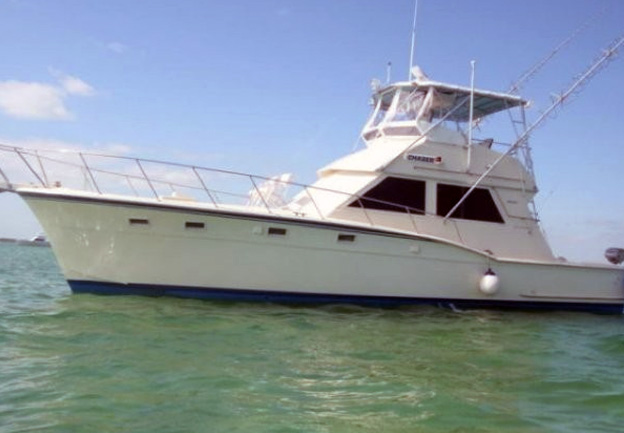- Alaskan Yachts
- Azimut Yachts
- Back Cove Yachts
- Beneteau Yachts
- Benetti Superyachts
- Bertram Yachts
- Boston Whaler
- Broward Yachts
- Buddy Davis Sportfish
- Burger Yachts
- Cabo Yachts
- Catamarans
- Carver Motoryachts
- Center Console
- Chris-Craft Yachts
- Cruisers Yachts
- DeFever Trawlers
- Dufour Sailboats
- Fairline Yachts
- Feadship Yachts
- Ferretti Yachts
- Formula Yachts
- Fountaine Pajot Cats
- Grady-White
- Grand Banks Trawlers
- Hargrave Yachts
- Hatteras Yachts
- Hinckley Picnic Boats
- Horizon Yachts
- Hydra-Sports
- Intrepid Boats
- Jarrett Bay Sportfish
- Jeanneau Yachts
- Kadey-Krogen Trawlers
- Lazzara Yachts
- Luhrs Sportfish
- Marlow Yachts
- Maritimo Yachts
- Marquis Yachts
- McKinna Motoryachts
- Meridian Yachts
- Midnight Express
- MJM Yachts
- Mochi Craft
- Neptunus Motoryachts
- Nordhavn Trawlers
- Nordic Tugs
- Ocean Alexander Yachts
- Offshore Yachts
- Outer Reef
- Oyster Sailing Yachts
- Pacific Mariner Yachts
- Palmer Johnson Yachts
- Pershing Yachts
46 Hatteras Convertible
![]()

Source: Peter Bohr, Sea Magazine
Hatteras 46 Convertible stands the test of time
The Hatteras name conjures up magic to many power boat aficionados.
Since 1959, the company’s craftsmen in High Point, North Carolina have been turning out some of the world’s most esteemed motoryachts and convertible sportfishers.
Unlike other venerable boat manufacturers — and despite being located in the heart of America’s furniture-building industry area — Hatteras never built a hull from timber.
When the company was founded, others were building relatively small craft out of a new, promising material called fiberglass. Hatteras’ first production boat was a 41-footer, and the company pioneered the way as a builder of large fiberglass boats.
Today, Hatteras is part of Irwin Jacobs’ boat building empire, which includes Wellcraft, Glastron and many other companies. And Hatteras is still turning out big fiberglass yachts, renowned for their high quality and their high price tags.
Among the dozens of models offered by the company during the last three and a half decades, the Hatteras 46 Convertible ranks as one of the company’s most popular models ever. Between 1973 and 1985, some 270 of them left High Point: not bad for a boat that sold for almost $400,000 during its last year of production.
The 46 Convertible is the very paradigm of an American sportfisher. It’s not a flashy design — Hatteras boats never are — but it is still remarkably handsome nearly 10 years after production ended.
Like other Hatteras boats, the 46 Convertible was a carefully conceived, evolutionary step forward from the models that came before it.
The 46-footer’s hull design is not vastly different from that of the original Hatteras 41. Both were designs from J.B. Hargrave, a naval architect still closely associated with Hatteras. The 46 has a modified-V hull with a deep, full-length keel and a moderate transom deadrise.
By all accounts from those who’ve spent much time aboard a 46, this rather basic design works well under all kinds of sea conditions — whether going down swell, across a quartering sea
or beating into a sea. The boat is generally dry and is not given to rolling either at anchor or at trolling speeds.
But the 46 Convertible’s deep forefoot, though good in head seas, does slow the boat down a bit.
In its early years, the 46 came with a pair of 450 hp 8V-71TI Detroit Diesels. Cruising speed is a modest 20 to 21 knots — and at that speed, the 46 burns 32 gallons of fuel an hour.
For 1982, Hargrave beefed up the boat with extra transverse frames, stiffened the sides of the solid fiberglass hull with a backing of balsa core and shortened the keel. Then, Hatteras installed a pair of muscular 650 hp 8V-92TI Detroit diesels.
This high-performance version of the 46 Convertible was built to cruise at 26 knots and top out at 29 knots. But fuel consumption jumped too, to 51 gallons an hour.
The 46 is a true convertible. Its comfortable accommodations make it a popular cruiser, but its forte is, of course, fishing.
With a cockpit that measures nearly 9 feet long by 10 feet wide — plus a roomy flying bridge — the 46 has lured many a serious angler.
Two floor plans were offered. The galley-down arrangement is clearly the choice of anglers — or anyone expecting to spend much time at sea. It offers two staterooms, each with twin berths and its own head compartment.
The galley-up layout crowds the deckhouse but leaves room for a third stateroom below, plus a master stateroom with an island queen-size berth. This latter feature can be cozy dockside, but it can also be mighty uncomfortable in lumpy seas while under way.
With either arrangement, vast amounts of stowage are available in hanging lockers, drawers and under-berth compartments.
As you might expect of any Hatteras, the 46 brims with features that indicate quality and thoughtful design. For example, the engine room is almost stand-up size (in contrast to the hands-and-knees room on say, a Bertram 46 of the same vintage).
Fuel filters, separators and manifold switches are clearly marked and placed. All wiring is both color-coded and numbered.
And the primary generator is in the engine room, in its own soundproof box. Many 46-footers carry the generator under the cockpit sole, where it’s more likely to get wet.
“Hatteras boats stand up well during the survey process,” said Gary Stevens, owner of Maritime Consultants in Newport Beach. “They’re usually worth their premium in price.”
Hatterases, however, aren’t immune to hull blisters, though they’re no worse on Hatteras models than on most other boats, according to Stevens.
All this goodness means that these Hatteras 46 Convertibles hold their value exceedingly well.
While you may find a 1970s fixer for around $160,000, you should expect to pay close to $300,000 for a mid-1980s version with 650 hp diesels.